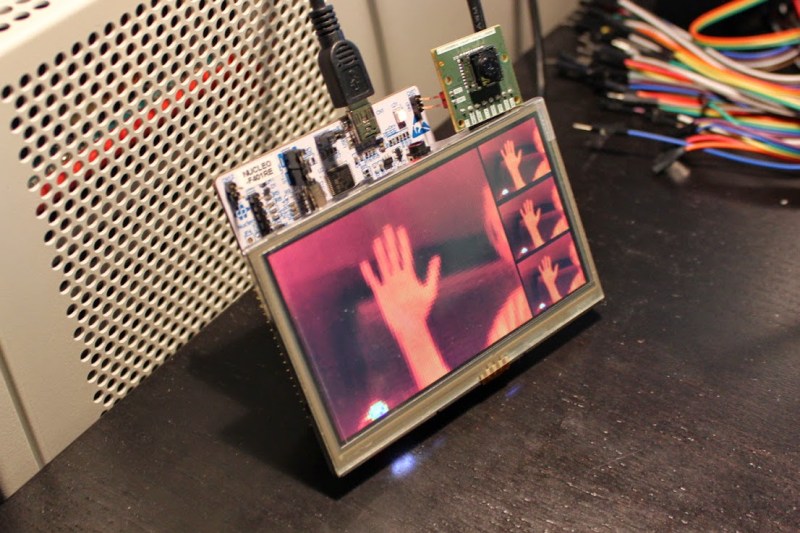[Andrew] designed a simple thermal imager using the FLIR Lepton module, an STM32F4 Nucleo development board, and a Gameduino 2 LCD. The whole design is connected using jumper wires, making it easy to duplicate if you happen to have all the parts lying around (who doesn’t have a bunch of thermal imaging modules lying around!?).
The STM32F4 communicates with the Lepton module using a driver that [Andrew] wrote over a 21MHz SPI bus. The driver parses SPI packets and assembles frames as they are received. Images can be mapped to pseudocolor using a couple different color maps that [Andrew] created. His code also supports min/max scaling to map the pseudocolor over the dynamic range present in the image.
Unfortunately the Lepton module that [Andrew]’s design is based is only sold in large quantities. [Andrew] suggests ripping one out of a FLIR ONE iPhone case which are more readily available. We look forward to seeing what others do with these modules once they are a bit easier to buy.

















We never know… the avarage person would ask who has a bunch of devboards lying around .-.
The Lepton is available in small quantities here: https://www.groupgets.com/campaigns/44-flir-lepton-thermal-imager-batch-3-reduced-price. Also at the link is information about accessories such as the breakout board used in the project above and sample code.
The high shipping cost if you don’t live in the US has put me off that group buy.
MORE THAN 48 BUCKS FOR SHIPPING?!? That is insane! OTOH, I’m quite certain that there are thousands of hackers in the US who would be more than happy to resend shipments on to whomever wanted them at a fair price.
Is this any better than the FLIR ONE?
I can almost guarantee that it is worse because my display is only RGB565 and non-remarkable resolutions.
It was fun to make though!
It’s an open, DIY project. Whether it’s better depends on YOU. If you just want a ready to use thermal imager, it’s probably not better.
But if you want to add software features not present in the closed iPhone app, interface it easily to other projects, or overclock the sensor past the export regulation mandated 8 frames per second, it’s better.
BTW, there’s a second group purchase for the Lepton ongoing. A little cheaper than buying a FLIR One to extract a Lepton from, though you might have to wait a while for delivery:
https://www.groupgets.com/campaigns/31-flir-lepton-thermal-imager-batch-2
Great post Chris and thanks for the link to us. We are now on batch 3 however, and that link is here: https://www.groupgets.com/campaigns/44-flir-lepton-thermal-imager-batch-3-reduced-price
Hmmm…this looks like a valid higher resolution alternative to the lepton… http://obtain.thermal.com/product-p/uw-aaa.htm
Those use a thermopile sensor which are just not as good as a microbolometer sensor like the lepton. So it is a tradeoff.
No.
This is a 206×156 vanadium oxide microbolometer. I own one. It is superior to the lepton module in resolution, however we are still dealing with post processing to get clean and pretty images. It is good enough as it is.
OK, the last time I heard they were using a thermopile array from these guys: http://www.heimannsensor.com/products_imaging.php
The Seek thermal usb camera has higher resolution than the lepton module and is only $199. I just ordered one a couple days ago.
http://www.thermal.com
The seek sensor is cool, but I don’t find the image quality to be as good as the Lepton. Check out mikeselectricstuff on YouTube. He has a fairly comprehensive teardown/review/issue analysis of the Seek sensor.
If Lepton was packaged in a Seek package that would be a killer product. I’m an Android user and the Flir One doesn’t work with the HTC One.
A mere 350 smackers for the module and break-out board… A mere pittance.
Hey Rusty, FLIR recently reduced the price of the FLIR One and the Lepton in single quantities.
I have something similar with the odroidw + the display breakout (a raspi clone).
Discussion here:
https://groups.google.com/forum/#!forum/flir-lepton
Some code here:
https://github.com/PureEngineering/LeptonModule
I also setup a bmp that can be refreshed via a webserver, and a 16 bit grayscale PNG for postprocessing.
Very cool (sic) project! What about using two modules for stereo vision? If you used two half-mirrors, could you not use regular cameras overlaying the FOV of each module, and get true interpolation based on the physical geometry of the environment?
you dont need mirrors, ordinary glass will do
Yes, one could do that; in fact, I used to work at a company doing just that. Most often the two (or more) imaging systems are simply next to each other as parallax isn’t an issue when imaging targets at a distance. What I would be very interested is to see the thermal image used in rendering a point cloud.
– Robot
Anyone interested in looking at the full datasheet, i have it posed up here:
http://www.pureengineering.com/projects/lepton
Along with a ton of other information on the lepton.